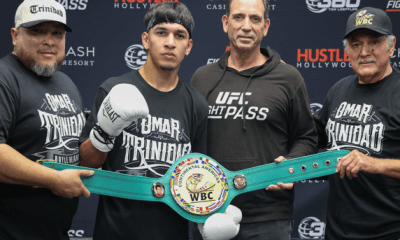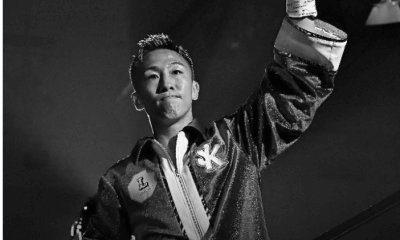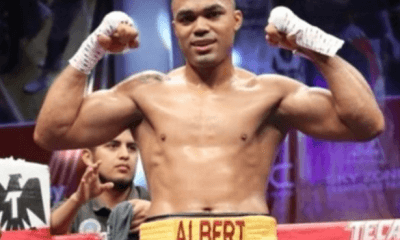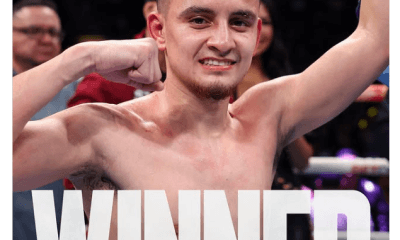Featured Articles
Boxing Notes and Nuggets from Thomas Hauser: ‘The Blue Corner’
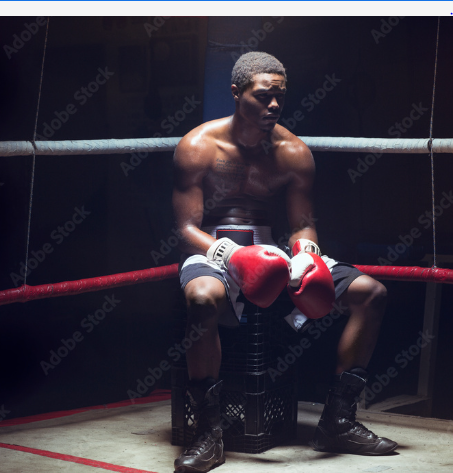
Boxing, like all sports, is more fun to watch when the viewer has a rooting interest. That interest can spring from a variety of factors. Some people like or dislike a particular fighter on a personal level. Others – let’s be honest – root for or against a fighter based on ethnicity.
If I don’t know either of the fighters in a fight, I root for the underdog.
That can be dispiriting. Too many fight cards today consist largely of A-side vs. B-side fights. As a general rule, the A-side fighter comes out of the red corner and the B-side fighter is seated in the blue corner. Upsets are few and far between.
Tom Loeffler’s March 15 fight card at Madison Square Garden’s Hulu Theater is a case in point. There are underdogs and then there are hopeless underdogs. I went to the fights hoping something that wasn’t supposed to happen would happen. But a look at the opponents’ records told me that was unlikely.
BoxRec.com is a wonderful tool for scoping out how competitive a fight is likely to be. Here’s what I learned from BoxRec.com before the fights and how things unfolded in the ring.
Fight #1: Giovanni Scuderi (9-0, 4 KOs) vs. Brandon Carmack – Scuderi’s last opponent had 57 losses. And that opponent might have beaten Carmack. I’m sure Brandon could decimate most people in a bar fight. But he lumbered around the ring like a heavybag with feet. Scuderi telegraphs every righthand he throws. But he has a basic jab. The match had the appearance of a picador sticking lances into a slow sluggish bull. W4 for Scuderi.
Fight #2: Nisa Rodriguez (0-0) vs. Jozette Cotton – Rodriguez is a 33-year-old New York City police officer with an extensive amateur background who was making her pro debut. Cotton was winless in four pro fights. Rodriguez fought tentatively. Cotton had a roll of flab around her waist (which spoke to her conditioning) and fought like she didn’t know how to box. W4 for Rodriguez.
Fight #3 Joseph Ward (10-1, 6 KOs) vs. Derrick Webster – Webster is 41 years old and has now won one of six fights since 2018. KO 2 for Ward.
Fight #4: Reshat Mati (14-0, 8 KOs) vs. Irving Macias – Macias has lost three of his last four fights, and the guy he beat during that stretch has 19 losses (including his last seven fights in a row). W8 for Mati.
Fight #5: Cletus Seldin (27-1, 23 KOs) vs. Jose Angulo – Angulo has lost six of his last eight fights, including four KOs by. W8 for Seldin, Here, I should note that, after the fight, Seldin took the ring announcer’s microphone, dropped to one knee, opened a small box containing a diamond engagement ring, and asked one Jessica Ostrowski to marry him. The future Mrs. Seldin (who was clad in black leather) said yes, and the happy couple paraded around the ring together.
Fight #6: Feargal McCrory (15-0, 7 KOs) vs. Carlos Carlson – Carlson has had ten fights since 2016 and lost seven of them. The three guys he beat during that stretch have 92 losses between them. And he hadn’t fought in more than two years. Referee David Fields did the fans a favor by stopping the bout prematurely in round three. If Carlson had fought as vigorously during the fight as he complained about the stoppage afterward, it would have been a better fight.
Fight #7: The main event matched Callum Walsh (9-0, 7 KOs) against Dauren Yeleussinov. Walsh is a 23-year-old junior-middleweight who UFC CEO Dana White is trying to build as a boxing version of Conor McGregor. Yeleussinov has lost three of his last four fights (including a first-round KO by). And the opponent Dauren beat during that stretch has 22 losses (including a current losing streak of 19 a row). Yeleussinov was tailor-made for Walsh – slow on his feet with slow hands and not much of a punch. Callum got off first all night. KO 9.
In six of the seven fights, the underdog lost every round.
I’m tired of fighters who talk tough and posture at press conferences but won’t fight an opponent who’s remotely competitive. And yes; I know that prospects can’t go in tough every time out. But a prospect’s opponent should pose some kind of challenge.
And let’s be honest; most of the fighters on the March 15 card were there because they were local ticket-sellers, not prospects. Only Walsh has world-class potential. He’s 23 years old with skills and is getting better. Right now, he’s a very good club fighter. Let’s see if he becomes something more.
* * *
One moment from promoter Larry Goldberg’s March 7 club-fight card at Sony Hall in New York stands out in my mind.
In the second fight of the evening, Jason Castanon and Luis Rivera-Reyes squared off against one another in a scheduled four-round junior-welterweight bout. Each man was making his pro debut. Castanon’s opponent had pulled out the previous week, leaving matchmaker Eric Bottjer scrambling for a new opponent. Rivera-Reyes had been scheduled to fight on the undercard of a show in Puerto Rico but his opponent had also fallen out, so he was available.
Bottjer thought that Castanon vs. Rivera-Reyes would be a competitive fight. Each man was old for a boxer making his pro debut. Castano is 30; Rivera-Reyes is 35. But they had comparable amateur backgrounds.
Rivera-Reyes held his own in round one. But Castanon was the stronger, better-schooled fighter. In round two, Luis started getting beaten up. The punishment mounted in round three. Rivera-Reyes was still trying to win but it was a futile effort. With seconds left in the third stanza, a righthand staggered Luis and a second righthand put him down hard. He rose through an incredible act of will because that’s what real fighters do. But he was badly hurt and on wobbly legs. Referee Eddie Claudio asked if he wanted to continue.
Rivera-Reyes shook his head. No.
Afterward, an uncharitable observer said that Luis “quit.”
I think that Luis acted with honor. Sitting several feet from the ring, I had a perfect view of the pain and despair etched on his face as he confronted the reality that he was a beaten man. He didn’t jump to his feet at the count of ten-and-a-half, pretending that he was ready to keep fighting. He didn’t ignore the referee’s question and feign outrage when the fight was stopped. He acknowledged that he had given his all and was beaten. Fighters aren’t video-game figures. They get hurt. And sometimes they just can’t take anymore.
The moment reminded me of the 1983 rematch between Alexis Arguello and Aaron Pryor. Pryor had won their classic first encounter with a brutal knockout that left Arguello unconscious on the ring canvas. In round ten of Pryor-Arguello II, Alexis found himself on the canvas again. He was a warrior, one of the greatest fighters of all time. He could have gotten up. But he didn’t. He had done the best he could and realized that it was over. He sat with tears streaming down his face and later acknowledged. “It’s hard to accept, but it’s good to accept. I did it with grace and just accepted that the guy beat me. Even though I did my best, in the tenth round I accepted it right there. I said, ‘This is too much. I won’t take it. I‘ll just sit and watch Richard Steele count to ten.'”The look in Luis Rivera-Reyes’s eyes when he shook his head will stay with me for a long time. He had been beaten into submission in his first pro fight. And I wondered, how long will he hold onto the dream.
* * *
A nod to “March Madness” which begins this week . . .
College basketball has a problem – court storming.
It’s now in vogue for fans of the home team to surge onto the court after a big win. Tearing down the goal posts in football endangers fans who are tearing down the goal posts. Court storming endangers the players.
On January 21, Caitlin Clark (Iowa’s superstar guard) was knocked to the floor when Ohio State fans stormed the court after a big win.
On February 24, Kyle Fitzpatrick (Duke’s All-American center) injured his knee when Wake Forest fans stormed the court after a dramatic upset.
To date, the NCAA has done nothing about the problem. Several conferences have taken action on their own, the most notable example being the SEC which instituted an escalating fine that begins at $100,000 for the first incident. By contrast, the ACC has no penalty for court-storming; the Big Ten has no penalty until the third incident; and the Big East penalizes offending schools the paltry sum of $5,000.
It shouldn’t be hard to end court storming.
The NCAA should institute a rule – and fans should be advised late in each contest – that court storming will result in forfeiture of the game.
***
Thomas Hauser’s email address is thomashauserwriter@gmail.com. His next book – MY MOTHER and me – is a personal memoir that will be published by Admission Press on April 2 and is available for pre-order at Amazon.com.https://www.amazon.com/My-Mother-Me-Thomas-Hauser/dp/1955836191/ref=sr_1_1?crid=5C0TEN4M9ZAH&keywords=thomas+hauser&qid=1707662513&sprefix=thomas+hauser%2Caps%2C80&sr=8-1
In 2004, the Boxing Writers Association of America honored Hauser with the Nat Fleischer Award for career excellence in boxing journalism. In 2019, Hauser was selected for boxing’s highest honor – induction into the International Boxing Hall of Fame.
To comment on this story in the Fight Forum CLICK HERE
-

 Featured Articles3 weeks ago
Featured Articles3 weeks agoThe Hauser Report: Zayas-Garcia, Pacquiao, Usyk, and the NYSAC
-

 Featured Articles2 weeks ago
Featured Articles2 weeks agoOscar Duarte and Regis Prograis Prevail on an Action-Packed Fight Card in Chicago
-

 Featured Articles1 week ago
Featured Articles1 week agoThe Hauser Report: Cinematic and Literary Notes
-

 Book Review4 days ago
Book Review4 days agoMark Kriegel’s New Book About Mike Tyson is a Must-Read
-

 Featured Articles4 weeks ago
Featured Articles4 weeks agoManny Pacquiao and Mario Barrios Fight to a Draw; Fundora stops Tim Tszyu
-

 Featured Articles4 weeks ago
Featured Articles4 weeks agoArne’s Almanac: Pacquiao-Barrios Redux
-

 Featured Articles3 weeks ago
Featured Articles3 weeks agoRemembering Dwight Muhammad Qawi (1953-2025) and his Triumphant Return to Prison
-
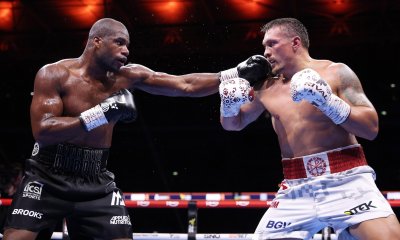
 Featured Articles4 weeks ago
Featured Articles4 weeks agoOleksandr Usyk Continues to Amaze; KOs Daniel Dubois in 5 One-Sided Rounds


